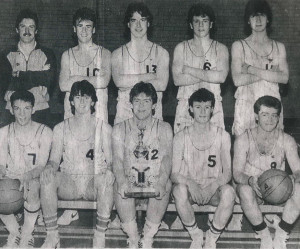I hear what you’re saying. At least I think I do.
Clearing out some old storage boxes recently I came across a ‘mixtape’ which for the uninitiated is something described by Urban Dictionary as:
“A mix featuring songs that have been carefully chosen, mixed and recorded onto an analog or digital medium. The name Mixtape is used because they were originally mixed and recorded onto cassette tapes by DJs in the 70’s 80’s and 90’s “
The cassette was painted / graffitied for some reason and dated back to 1987/88 when I was sampling student life in the North East of England.
I don’t have anything to play it through but on seeing the cassette and its curious livery, I can remember immediately the songs – almost sequentially.
(Black Uhuru, Great Train Robbery, Peter Tosh and Mick Jagger, Walk and don’t look back, James Taylor, Everyday, Van Halen, Why Can’t his be love, Champion Doug Veitch, Jumping into love, Pretenders, Brass in Pocket, The Clash, Train in Vain.)
Back then it was hard work putting together such a diverse mixtape – compared to today, it was a nightmare.
I think that maybe there is a correlation between the effort put into making the mix tape, the number of times played and the ability to recall the track listing.
That cassette was was played to death – it was a long train journey from the North East to the Moy.
14 hours.
As for the songs recorded?
It’s all subjective and I can stand over that 1980s mixtape today because music means as much to me now as it did then but thankfully Spotify has made the process a whole lot easier.
Anyway, I’ll take this opportunity to introduce you to a different kind of playlist / mixtape.
Mindlab International, a behavioural science agency and part of the University of Sussex, carried out research into the influence of sound on stress and anxiety. One output of that research was a top 10 playlist – available on Spotify – of the most relaxing music, some of which comes with the instruction “Do not listen to whilst driving”
Top of that list was a song called Weightless by Marconi Union.
The song was created in collaboration with sound therapists and the composition took into account carefully arranged harmonies, rhythms, and bass lines which were included to help slow a listener’s heart rate, reduce blood pressure and lower levels of the stress hormone cortisol.
Cool, huh?
We humans can detect sounds in a frequency range from about 20 Hz to 20 kHz – the upper limit in average adults is often closer to 15–17 kHz. Bats by comparison can hear ultrasonic sounds with frequencies up to 110,000 hertz whilst elephants hear sounds many times lower than those a human can perceive.
Just after WWII a German physicist, Winfried Otto Schumann, mathematically documented the electromagnetic resonances existing between the Earth’s surface and the ionosphere (the electrically charged part of the Earth’s atmosphere. )
Schumann discovered that these electromagnetic waves, originating from discharges of lightening, resonated at a low frequency ranging between 7.86 Hz to 8 Hz.
He determined that this frequency was, in essence, the Earth’s heartbeat.
Which leads me on to ‘solfeggio frequencies.’
You will all be familiar with Solfeggio frequencies but may not know it.
I was introduced to them formally a few years ago by my partner but I had already been exposed to them as a child at primary school.
Do you remember “Do-re-me-fa-sol-la-ti-do”?
Solfeggio frequencies refer to specific tones of sound that help with and promote various aspects of body and mind health.
They are considered as the fundamental sounds used in both Western Christianity and Eastern Indian religions, chanted by the Gregorian Monks and in ancient Indian Sanskrit chants.
(Do-re-me-fa-sol-la-ti-do is the mnemonic to a solfeggio written about John The Baptist.)
I find sound and music fascinating.
Think about all those sounds that we hear and all those sounds we cannot hear.
Layer on top of that the stuff we choose not to hear.
That which we ignore or simply don’t understand.
Factor in some of those 28 cognitive biases that play with our minds – let’s start with blind spot bias, confirmation bias and the ostrich effect for now – and then the next time you are in the middle of a sales discussion with a prospect or potential customer, ask yourself the question :
‘Am I really a good listener?’
.
.
.
.
.
.
Shift Control is a business development consultancy specialising in sales strategy, sales management, customer service, sales training and coaching.
To find out how we can add value to your business please email info@shift-control.co.uk
Sales Training and Coaching. Skills Development. Management coaching.







